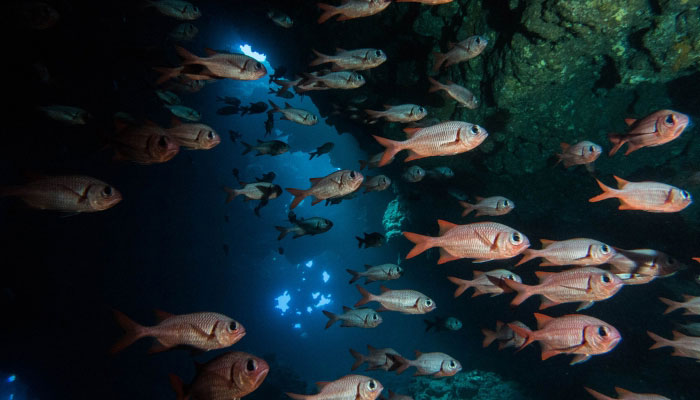
Cave Diving - Everything You Need to Know
Cave diving is an experience like no other. The underwater life that inhabits these mysterious formations is, without a doubt, unique and impressive. In addition, it is an activity that motivates teamwork and helps us to balance emotions such as fear, panic or nerves .
If adrenaline is your thing and you are passionate about discovering new worlds under the sea, this kind of dives will leave you amazed. But first, make sure you clarify all your doubts, check what equipment you need (and what not), what are the requirements for cave diving and get advice from experts so you can enjoy with confidence.
In our post we will guide you on what exactly is cave diving, why you should say YES to an adventure like this and we tell you what you should always take into consideration before embarking on your adventure under the sea. Stick around and find out all about it.
What does Cave Diving consist of?
Cave diving is an extremely tempting proposal for any adventurous diver. With this modality we can learn to explore underwater caves in a safe and responsible way.
It can be distinguished because in this type of immersions we reach beyond the area where we have natural light and we do not have easy access to the surface. Taking this into account, it is more than evident that this discipline requires a gradual learning, as well as it implies knowing the essential elements and the techniques that we must apply in this type of scenarios.
Therefore, this is not an activity suitable for those who are just starting out in the world of diving, but for those with a certain level of training who are looking for new experiences.
Cave Diving and Cavern Diving Are they the same?
No.❌ Although at first glance they may appear to be the same activity, the truth is that they differ markedly.
First of all, in cavern diving divers usually dive to a maximum depth of 60 meters and therefore have a certain level of sunlight that facilitates underwater vision. In addition, the exit in this case must always be visible while we are diving.
However, when it comes to cave diving, it requires a more advanced level of preparation, since it is a discipline that requires going deeper, exploring under underwater rocks. All this implies a low level of illumination and, therefore, a more limited vision of what is at the bottom.

4 Reasons to Dive in Caves
Beyond being a discipline that allows you to acquire a higher level of experience and preparation in the world of diving, it is also a great opportunity to:
- Discover an endless number of wonderful animals that you won't find anywhere else in the world. For example, in places like the Cuevas de las Gambas you will see swarms of narwhal shrimps, groupers, garden eels, white fulla, flabellines and even sea slugs that gleam with their intense violet color.
- Appreciate absolutely breathtaking underwater landscapes, with rock formations such as stalactites and stalagmites that look like something out of a movie.
- Learn how to handle emergency situations and disorientation, as well as how to move safely inside the caves.
- Know how to manage emotions such as panic and nerves. You will be able to stay calm and rely on problem-solving training.
- Reinforce the concept of teamwork, because in the caves your companions could be your lifeline in any situation.
What to Consider Before Cave Diving
Physical condition
For a normal dive it is important to be in good health, but when it comes to cave diving this is essential, as it is a key factor in reducing the risk of decompression sickness.
Therefore, if you are planning to explore some underwater caves, we recommend you to do some kind of aerobic exercise regularly , at least 2 or 3 times a week, and to follow a good diet.at least 2 or 3 times a week and follow a good diet.
Previous experience
Cave dives also have a certain level of demand with respect to the experience we may have previously. For example, it will be useful if we have knowledge in nitrox diving or rescue diving, in addition to having done simple dives before.
In fact, it is sometimes recommended to have done at least 10 to 12 dives in the 6 months prior to our cave adventure.
Likewise, mastering buoyancy techniques, both in confined and open water, is absolutely necessary to perform this activity without problems. It is also important to know how to make a 360-degree turn just by paddling with the fins.

To have the necessary equipment
Cave diving is distinguished by the high level of demand, not only on a physical level, but also in the equipment. The most essential thing is to carry as little equipment as possible, in as little volume as possible and only as much weight as possible.
To give you a better idea of how you will organize your equipment when cave diving, we will explain below what you need to take with you and what factors you should consider:
- Vest and regulator
- Suit
- Light spotlight
- Fins
- Knife
- Reel
At Titan Blue Divers we are passionate about new adventures and we are ready to answer all your questions about this type of diving. Also, if you are looking for training to dive in caves with total confidence or if you are looking for a fun and professional team to start your underwater journey, we prepare the best guided dive packages for you!
If you have any questions you can leave us a comment below. Now, if you want to know how to get your diving certification and make your dives as an expert, check our diving courses in Lanzarote for all levels.

